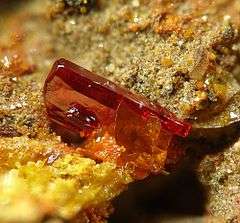Phoenicochroite
| Phoenicochroite | |
|---|---|
|
Deep red Phoenicochroite cystal, with orange-yellow schwartzembergite. San Francisco Mine, Tocopilla Province, Chile. Photo width 1.5 mm. | |
| General | |
| Category | Chromate mineral |
| Formula (repeating unit) | Pb2O(CrO4) |
| Strunz classification | 07.FB.05 |
| Crystal system | Monoclinic |
| Space group |
Monoclinic prismatic H-M symbol: (2/m) Space group: C 2/m |
| Unit cell |
a: 14 Å, b: 5.67 Å, c: 7.13 Å β: 115.22° |
| Identification | |
| Color | Dark red, bright red |
| Crystal habit | Tabular crystals; thin coatings, and massive |
| Cleavage | Perfect on {201} |
| Tenacity | Sectile |
| Mohs scale hardness | 2½ |
| Luster | Adamantine, resinous |
| Streak | Brick-red |
| Diaphaneity | Translucent |
| Specific gravity | 7.01 |
| Optical properties | Biaxial (+) |
| Refractive index | nα = 2.380, nβ = 2.440, nγ = 2.650 |
| Birefringence | 0.270 (δ) |
| 2V angle | 58° (measured) |
| References | [1][2][3] |
Phoenicochroite, also known as melanochroite, is a lead chromate mineral with formula Pb2OCrO4. It forms striking orange red crystals. It was first discovered in 1839 in Beryozovskoye deposit, Urals, Russia.[1] It is named from the Greek word φοίυικος for "deep red" and χρόα for "color," in allusion to its color.[1]
References
| Wikimedia Commons has media related to Phoenicochroite. |
This article is issued from Wikipedia - version of the 12/28/2014. The text is available under the Creative Commons Attribution/Share Alike but additional terms may apply for the media files.
